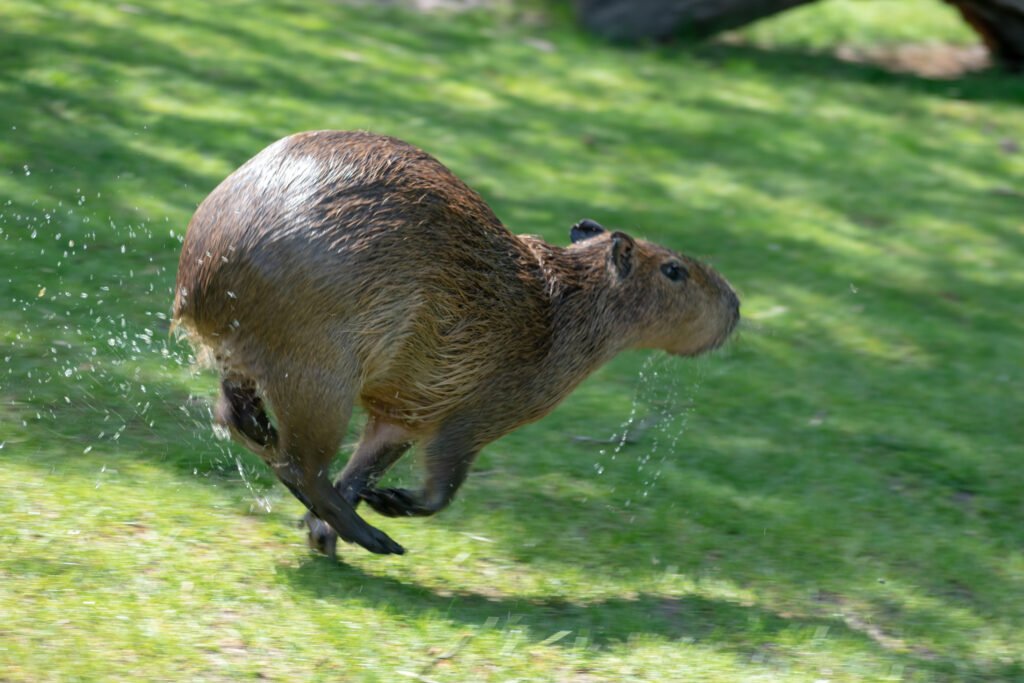The Sprinter of the Swamps: Why Capybaras Are Surprisingly Fast Runners
Updated August 10, 2025
The capybara is a global icon of relaxation. From viral capybara images showing them in a hot spring to the gentle capybara meme that has taken over the internet, their reputation is built on a foundation of unbothered, slow-moving tranquility. This image, however, hides a surprising truth: when the situation demands it, this peaceful giant can be a surprisingly fast runner.

In this blog post, we’ll dive into a fascinating capybara fact that often goes overlooked. We’ll explore the hidden athleticism of the capybara animal, examining why their speed is a vital part of their survival strategy, how their unique body is built for a quick getaway, and why you should never underestimate the power behind their chill demeanor.
Built for a Quick Getaway: Anatomy of a Sprinter
At first glance, the capybara doesn’t look like an athlete. With its barrel-shaped body, short legs, and an average weight that can reach over 145 pounds, it seems more suited for a slow, meandering pace than a sprint. But looks can be deceiving.
Their body, while stout, is packed with power. Their legs are short but strong, designed to provide a quick burst of speed when needed. This explosive power is a key defense mechanism. When a predator appears, their goal isn’t to outrun it over a long distance, but to get to the nearest body of water as quickly as possible. This is where their speed on land becomes a crucial, life-saving skill.
The Need for Speed: A Life-Saving Dash
In their natural capybara habitat of South American wetlands, the threats are real and they are fast. Predators like jaguars, pumas, and ocelots are formidable hunters with incredible speed and agility. For a capybara animal, a slow walk is a luxury reserved for times of peace. A fast dash is a necessity for survival.
The capybara’s speed is a tool to cover the short distance between its grazing spot and the safety of the water. Their speed has been estimated at around 22 miles per hour (35 km/h), which is surprisingly quick for an animal of its size and shape. This burst of speed is their last line of defense before they hit the water, where they are far more agile and in control.
The moment a capybara noise, a bark from a watchful herd member is heard, the entire group will break into a sprint. This synchronized rush to the water is a powerful display of their group cohesion and their hidden athleticism.
Masters of the Water: Agile and Elusive
While their speed on land is impressive, the capybara’s true mastery is in the water. Their semi-aquatic nature is what truly sets them apart. They are not just fast runners; they are also excellent swimmers and divers.
Their high-set eyes, ears, and nostrils are perfectly positioned on top of their heads, allowing them to swim with their heads barely above the surface, observing their surroundings while staying mostly submerged. They can also hold their breath for up to five minutes, enabling them to dive underwater to escape or hide from predators. Their partially webbed feet provide powerful propulsion in the water, making them incredibly agile and elusive to anything chasing them. A predator that chases a capybara in water often finds itself outmatched.
From Survival to Social Bonding
The capybara’s ability to be fast is deeply tied to its social structure. The survival of the herd depends on every member being able to make that crucial dash to the water. A herd member that is slow or inattentive puts the entire group at risk. This constant need for alertness and group cohesion is what makes the capybara such a fascinating creature to study.
This surprising physical ability is one of many capybara fun facts that adds another layer of depth to their seemingly simple life. It challenges the image of a completely relaxed creature and reveals a resilient, survival-focused capybara that is always on guard.
Capybaras in Captivity: A Different Kind of Speed
For those who are fascinated by the capybara and might be considering a capybara as a pet, understanding this aspect of their biology is important. While a pet capybara may not need to outrun a jaguar, its instincts remain the same. They still need a large, safe outdoor space where they can run, as well as a clean pool to swim in. This fulfills their natural need for both land-based movement and aquatic refuge.
The capybara’s image as a slow, peaceful animal is well-earned, but it’s only half the story. Their ability to be surprisingly fast is a testament to their adaptability and their deep-seated survival instincts. It’s a powerful reminder that in the wild, even the most serene-looking creatures have a hidden strength, ready to be unleashed in a moment’s notice.
